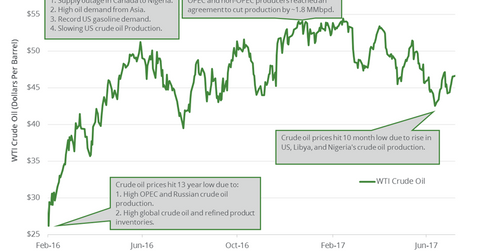Will US Crude Oil Prices Outperform in 2H17?
WTI crude oil (BNO) (PXI) (UCO) (XOP) prices have fallen 18% year-to-date. They have fallen 7% in the past year due to bearish drivers.
Nov. 20 2020, Updated 4:38 p.m. ET

Energy calendar this week  
Let’s track some important events for oil and gas on July 17–21, 2017.
- July 17 – The EIA (U.S. Energy Information Administration) will release its monthly drilling productivity report.
- July 18 – The American Petroleum Institute will release its weekly petroleum status report.
- July 19 – The EIA will release its weekly petroleum status report.
- July 20 – The EIA will release its weekly natural gas inventory report.
- July 21 – Baker Hughes will release its US crude oil and natural gas rig count report.
Crude oil futures 
WTI (West Texas Intermediate) crude oil (BNO) (PXI) (UCO) (XOP) prices have fallen 18% year-to-date. They have fallen 7% in the past year due to bearish drivers.
Lower crude oil prices have a negative impact on oil producers such as ExxonMobil (XOM), ConocoPhillips (COP), Carrizo Oil & Gas (CRZO), and PDC Energy (PDCE).
High and low  
US crude oil prices settled at $54.45 per barrel on February 23, 2017—the highest level in more than two years. On the other hand, prices hit $26.21 per barrel on February 11, 2016—the lowest level in more than a decade.
Crude oil price forecasts 
The EIA estimates that US crude oil prices averaged $50 per barrel for 1H17. Crude oil prices are expected to average $48 per barrel in 2H17. Barclays downgraded the Brent crude oil price forecast to $49 per barrel for 3Q17—$8 per barrel lower than previous estimates. High global crude oil inventories and a rise in crude oil production from the US, Libya, and Nigeria in 2017 led to the downgrade. Crude oil prices are expected to trade lower in the short term.
In the next part, we’ll look at how Cushing crude oil inventories impact prices.
